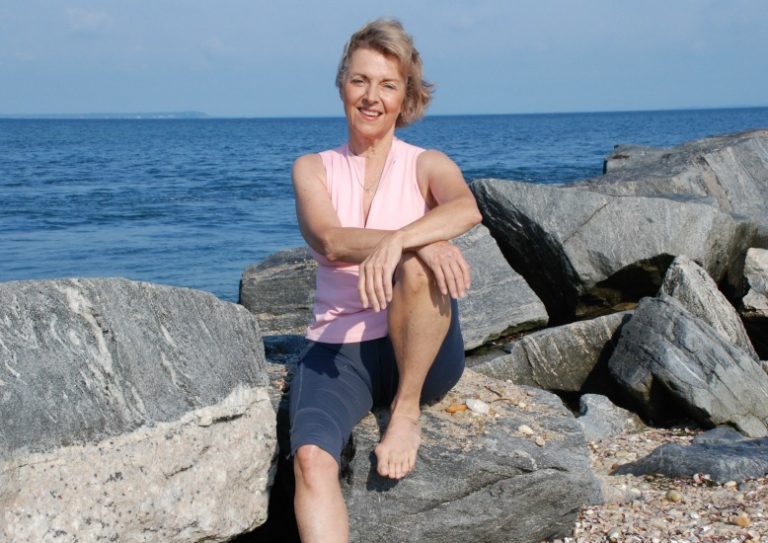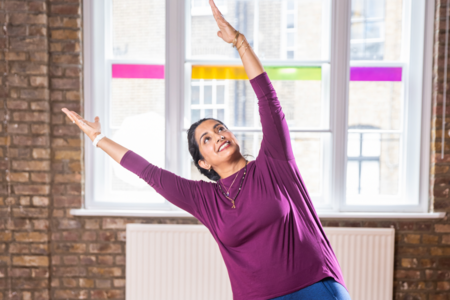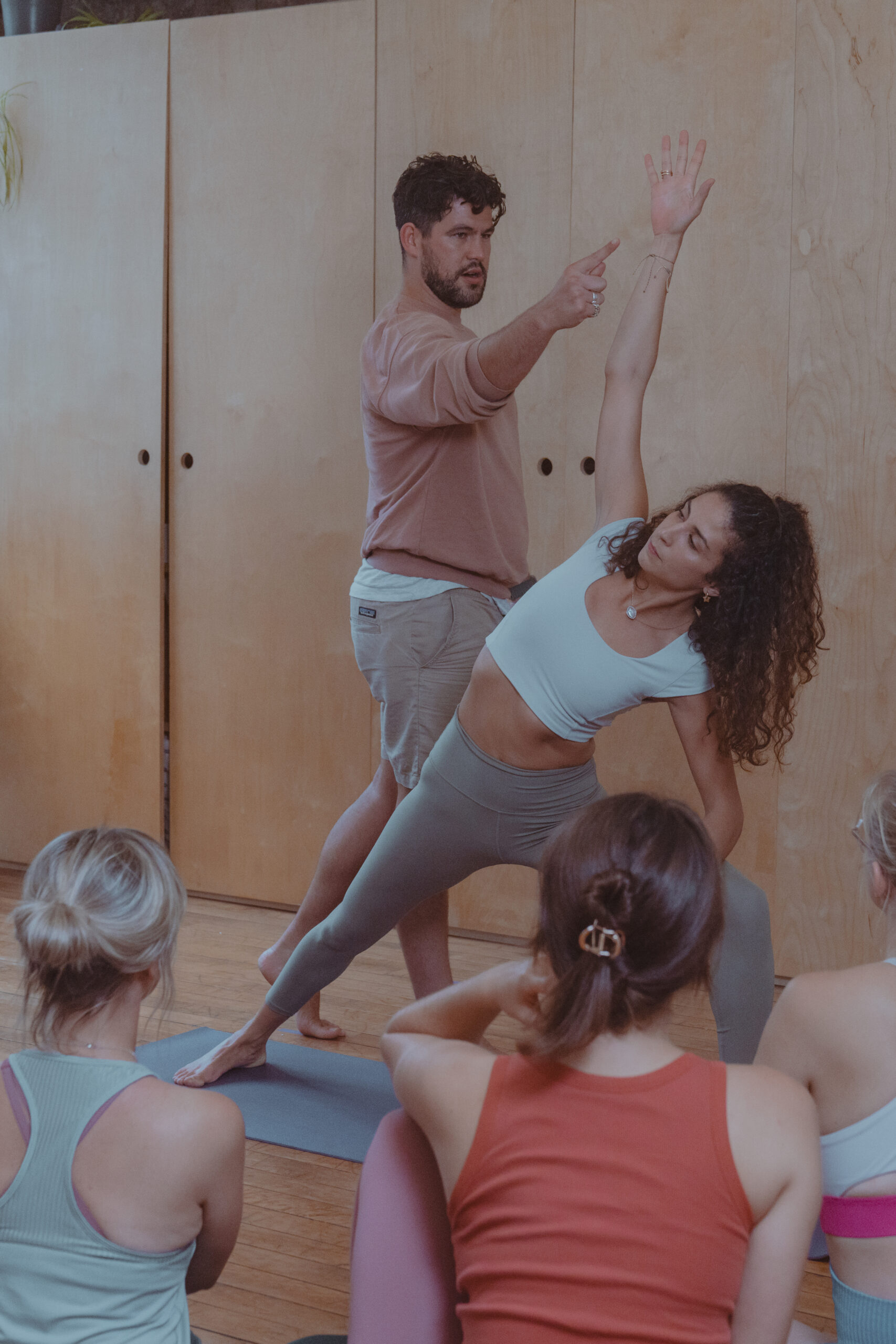Beryl is famous for coining the term “power yoga” and her classes in New York (and workshops all over the country) were the first and original “power yoga” programme. Based on the ashtanga sequences, Beryl adapted the practice for athletes of all sports, ages and abilities.
Ahead of her workshops at triyoga in September 2019 on “healing ourselves and the world”, she talks openly about power yoga’s beginnings and the many influences on her practice and teachings.
You’re renowned for coining the term “power yoga”. Why “power yoga”?
The name “power yoga” came to me in a meditation. I felt it was a great name and a great way to let Americans know (in the late 80s) that yoga could be a “workout” since prior to that yoga had been regarded as a pretty soft, stretchy sort of activity. It was also a name that Western mind could relate to, unlike the word “ashtanga” (at that time) and it was a great way to get men into the classes. Based on the work I was doing, I knew the incredible value that a rajasic (active) yoga practice like “power yoga” could offer to bodies and minds tight from training at sports. But I was an Ashtanga practitioner at the time, and to dare to call the modified version of the Ashtanga practice that I was teaching to athletes “power yoga” was regarded as pretty unorthodox! If it had been in the Middle Ages, it probably could have gotten me burned at the stake.
Over the years, it’s proved to be quite a contentious term in some ways. Why do you think that is?
I started practising Ashtanga yoga in l979 with Norman Allen in NYC. I had been teaching yoga for six years prior to that but the moment I experienced the Ashtanga practice, I felt like I had come “home”. I found what I had been looking for in India in l974, when I spent six months travelling and meditating with my teacher, Munishree Chitrabhanu, a Jain monk. I started teaching the Ashtanga practice about a year after I started doing it. But as the Wellness Director of the New York Road Runners Club at the time, I was teaching yoga to mostly runners and other athletes – and they were all so tight, that the only way they could really have access to the postures, was through variations and modifications. I couldn’t just rigidly adhere to “THE FORM!” Working with athletes safely required flexibility of thinking, as do most things in this world. So I began to “modify” the postures to make them accessible and called what I was doing “power yoga”. Of course, that was heretical to the hierarchy!
What reactions did you receive at the time?
Since my first Ashtanga teacher, Norman Allen, left NYC in the early 80s and moved to Hawaii, I ended up seeking out his teacher, Pattabhi Jois. I met Jois in l987 at the Feathered Pipe Ranch and between l987 and l992 I took nearly 300 led first and second series classes from him, all down the California coast, in Boulder, and in NYC. I was a very good student and respectful, and loved the practice but I never signed on to be a devotee of Sri Jois, as I wasn’t particularly inspired to do so. Although I felt he was a good “coach” I didn’t always like the way he treated people and especially didn’t like the way he treated women.
It has always been controversial to introduce a concept that goes against the prevailing paradigm in any field. The name “power yoga” got me thrown out of the Ashtanga “church” which was, in retrospect, an excellent thing, as it taught me, slowly over the years, to stand on my own two feet. A good thing for a woman in a man’s world to learn.
What influence do you think the book had on ashtanga hitting the “mainstream” in the ‘90s?
My book, Power Yoga, which I wrote in the early 90s, sold almost 300,000 copies, and which would be considered “going viral” today. By the early 90s we had 50-60 people in a class, half of them men, and were teaching eight classes a week. Between l980 and 2002, we taught over 100,000 people yoga. The book and the classes turned many people on to yoga – many of whom went on to study in India with various teachers. I still have people come up to me in workshops and retreats and say “you were my first yoga teacher in NYC at the New York Road Runners Club in l985” or l992, or when ever.
What is your own yoga background?
I began a lifelong meditation practice in l971, after studying with Chogyam Trungpa Rimpoche in San Francisco and with a Jain monk named Munishree Chitrabhanu (my guru) in New York City. Chitrabhanu was a Sanskrit scholar and first came to the US in l970 at the invitation of Harvard Divinity School to participate in the World Conference on Religions. He was the first Jain to ever leave India, which created quite a stir in the Jain community, as Jain monks traditionally did not travel by any conveyance other than their own feet. As a teenager in the late 40s, he joined Mahatma Gandhi’s non-violent passive resistance (satyagraha) movement for an independent India and entered the Jain monkhood at age 20. In l971 I also took my first asana classes with Yogi Bhajan (Kundalini yoga) and Swami Vishnudevananda (Sivananda yoga) in Los Angeles, and continued to study Sivananda yoga until l974. I also studied Iyengar yoga all through the 70s in California and Colorado and had the chance to take classes and retreats with Swami Satchidananda (Integral Yoga) in NYC.
Aside from Ashtanga, what practices and traditions have influenced your teaching?
I have been studying Consciousness and the Eastern Wisdom traditions for 48 years and am a 30-year student of the Yoga Sutras. I am most influenced by the non-dualists and the paths of Jainism, Buddhism, and Classical Yoga. I guess you could say that I am Buddhist/Jain or Jain/Buddhist yogi. What I like about all those methodologies is that they are very empirical. They do not require you buy into some ideology or dogma, in order to join the Club. You are just given a map, a set of instructions and told to follow the instructions and see what happens.
Another term you’re famous for is the “hard and the soft”. What do you mean by this?
I’m “famous” for that? I always thought it was way too long and too complicated for anyone to ever really remember. The name of my school, for example, is The Hard & The Soft Yoga Institute. That doesn’t exactly trip off the tongue. The name comes from a Zen proverb which says, “Only when you can be extremely soft and pliable can you be extremely hard and strong.” It refers to what Patanjali says in the Yoga Sutra about asana – that it should be both sthira and sukha (or effort and ease, hard and soft). I think that applies to everything in life – the “middle path” as the Buddha taught. When do you “hang on” and when do you “let go”? And how do you know when to do which? Right action comes out of skillful means and skillful means come out of practice.
How does what you teach now compare to what you taught 20 years ago?
Ask anyone reading this how what they teach or eat or believe or do or participate in is different from what they were doing 20 years ago. It’s like two different worlds! Celebrate impermanence. If you have a “practice” and are “doing the work” which means making an effort to be present, then transformation happens. Attention drives transformation. “Get your attention in present time and the future will take care of itself,” as Paramahansa Yogananda used to say.
Can you give students a flavour of what to expect at your triyoga workshop?
It totally depends on who is there and what the energy of the group is. But it will be fun, enlivening, inspiring and, hopefully, transformational. And most assuredly both hard and soft. Come and see for yourself.










